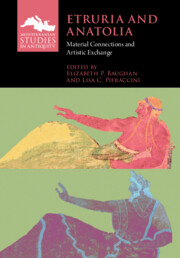Book contents
- Etruria and Anatolia
- Mediterranean Studies in Antiquity
- Etruria and Anatolia
- Copyright page
- Epigraph
- Contents
- Maps and Figures
- Contributors
- Preface
- Acknowledgments
- Notes on Abbreviations and Spelling
- Introduction
- Part I Broadening Perspectives
- Part II Interpretive Frameworks
- Part III Technology and Mobility
- Part IV Shared Practices
- 8 Etruscan Lightning and Anatolian Images
- 9 Luxury Consumption and Elite Lifestyles
- 10 Tracing Connections between Archaic Etruria and Anatolia in Material Culture and Funerary Ideology
- 11 Rock Tombs and Monuments in South Etruria and Anatolia
- Part V Shared and Distinct Iconographies
- Part VI Shared Forms, Distinct Functions
- Index
- References
10 - Tracing Connections between Archaic Etruria and Anatolia in Material Culture and Funerary Ideology
from Part IV - Shared Practices
Published online by Cambridge University Press: 02 March 2023
- Etruria and Anatolia
- Mediterranean Studies in Antiquity
- Etruria and Anatolia
- Copyright page
- Epigraph
- Contents
- Maps and Figures
- Contributors
- Preface
- Acknowledgments
- Notes on Abbreviations and Spelling
- Introduction
- Part I Broadening Perspectives
- Part II Interpretive Frameworks
- Part III Technology and Mobility
- Part IV Shared Practices
- 8 Etruscan Lightning and Anatolian Images
- 9 Luxury Consumption and Elite Lifestyles
- 10 Tracing Connections between Archaic Etruria and Anatolia in Material Culture and Funerary Ideology
- 11 Rock Tombs and Monuments in South Etruria and Anatolia
- Part V Shared and Distinct Iconographies
- Part VI Shared Forms, Distinct Functions
- Index
- References
Summary
Special pottery shapes (phialai and dinoi) with polychrome or relief decoration are the focus of this study. These vessels, deposited in Etruscan graves as “prestige pottery,” reveal the central role of southern Etruria in the cultural relationships between Anatolia, the eastern Aegean, and the Italic peninsula in the Orientalizing and Archaic periods. Caere and Vulci appear to be catalysts of many of these novelties, with a gradual handover from the first center to the second over the decades at the turn of the seventh and sixth centuries BCE.
Keywords
- Type
- Chapter
- Information
- Etruria and AnatoliaMaterial Connections and Artistic Exchange, pp. 182 - 194Publisher: Cambridge University PressPrint publication year: 2023

